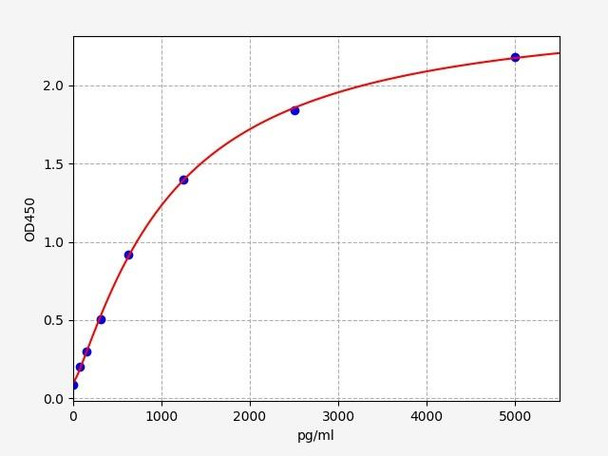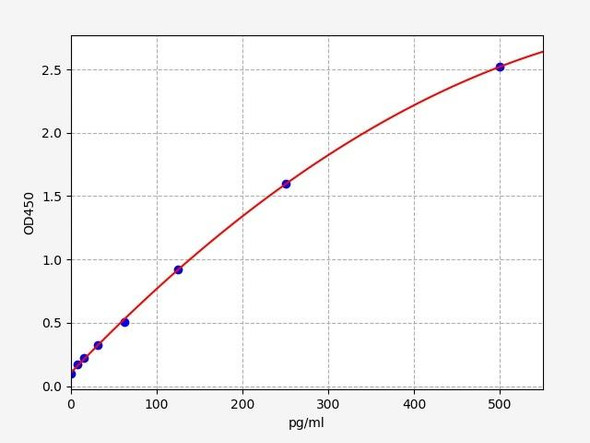Human MCFD2 / Multiple coagulation factor deficiency 2 ELISA Kit
- SKU:
- HUFI01453
- Product Type:
- ELISA Kit
- Size:
- 96 Assays
- Uniprot:
- Q8NI22
- Sensitivity:
- 46.875pg/ml
- Range:
- 78.125-5000pg/ml
- ELISA Type:
- Sandwich ELISA, Double Antibody
- Synonyms:
- MCFD2, Multiple coagulation factor deficiency protein 2, Neural stem cell-derived neuronal survival protein, SDNSF
- Reactivity:
- Human
Description
| Product Name: | Human MCFD2 / Multiple coagulation factor deficiency 2 ELISA Kit |
| Product Code: | HUFI01453 |
| Size: | 96 Assays |
| Alias: | MCFD2, Multiple coagulation factor deficiency protein 2, Neural stem cell-derived neuronal survival protein, SDNSF |
| Detection method: | Sandwich ELISA, Double Antibody |
| Application: | This immunoassay kit allows for the in vitro quantitative determination of Human MCFD2 concentrations in serum plasma and other biological fluids. |
| Sensitivity: | 46.875pg/ml |
| Range: | 78.125-5000pg/ml |
| Storage: | 4°C for 6 months |
| Note: | For Research Use Only |
| Recovery: | Matrices listed below were spiked with certain level of Human MCFD2 and the recovery rates were calculated by comparing the measured value to the expected amount of Human MCFD2 in samples. | ||||||||||||||||
| |||||||||||||||||
| Linearity: | The linearity of the kit was assayed by testing samples spiked with appropriate concentration of Human MCFD2 and their serial dilutions. The results were demonstrated by the percentage of calculated concentration to the expected. | ||||||||||||||||
| |||||||||||||||||
| CV(%): | Intra-Assay: CV<8% Inter-Assay: CV<10% |
| Component | Quantity | Storage |
| ELISA Microplate (Dismountable) | 8×12 strips | 4°C for 6 months |
| Lyophilized Standard | 2 | 4°C/-20°C |
| Sample/Standard Dilution Buffer | 20ml | 4°C |
| Biotin-labeled Antibody(Concentrated) | 120ul | 4°C (Protect from light) |
| Antibody Dilution Buffer | 10ml | 4°C |
| HRP-Streptavidin Conjugate(SABC) | 120ul | 4°C (Protect from light) |
| SABC Dilution Buffer | 10ml | 4°C |
| TMB Substrate | 10ml | 4°C (Protect from light) |
| Stop Solution | 10ml | 4°C |
| Wash Buffer(25X) | 30ml | 4°C |
| Plate Sealer | 5 | - |
Other materials and equipment required:
- Microplate reader with 450 nm wavelength filter
- Multichannel Pipette, Pipette, microcentrifuge tubes and disposable pipette tips
- Incubator
- Deionized or distilled water
- Absorbent paper
- Buffer resevoir
| Uniprot | Q8NI22 |
| UniProt Protein Function: | MCFD2: The MCFD2-LMAN1 complex forms a specific cargo receptor for the ER-to-Golgi transport of selected proteins. Plays a role in the secretion of coagulation factors. Defects in MCFD2 are a cause of factor V and factor VIII combined deficiency type 2 (F5F8D2); also known as multiple coagulation factor deficiency 2 (MCFD2). F5F8D2 is a blood coagulation disorder characterized by bleeding symptoms similar to those in hemophilia or parahemophilia, that are caused by single deficiency of FV or FVIII, respectively. The most common symptoms are epistaxis, menorrhagia, and excessive bleeding during or after trauma. Plasma levels of coagulation factors V and VIII are in the range of 5 to 30% of normal. 3 isoforms of the human protein are produced by alternative splicing. |
| UniProt Protein Details: | Protein type:Endoplasmic reticulum Chromosomal Location of Human Ortholog: 2p21 Cellular Component: endoplasmic reticulum membrane; ER-Golgi intermediate compartment membrane Biological Process: COPII coating of Golgi vesicle; ER to Golgi vesicle-mediated transport; protein amino acid N-linked glycosylation via asparagine Disease: Factor V And Factor Viii, Combined Deficiency Of, 2 |
| NCBI Summary: | This gene encodes a soluble luminal protein with two calmodulin-like EF-hand motifs at its C-terminus. This protein forms a complex with LMAN1 (lectin mannose binding protein 1; also known as ERGIC-53) that facilitates the transport of coagulation factors V (FV) and VIII (FVIII) from the endoplasmic reticulum to the Golgi apparatus via an endoplasmic reticulum Golgi intermediate compartment (ERGIC). Mutations in this gene cause combined deficiency of FV and FVIII (F5F8D); a rare autosomal recessive bleeding disorder characterized by mild to moderate bleeding and coordinate reduction in plasma FV and FVIII levels. This protein has also been shown to maintain stem cell potential in adult central nervous system and is a marker for testicular germ cell tumors. The 3' UTR of this gene contains a transposon-like human repeat element named 'THE 1'. A processed RNA pseudogene of this gene is on chromosome 6p22.1. Alternative splicing results in multiple transcript variants encoding distinct isoforms. [provided by RefSeq, Apr 2016] |
| UniProt Code: | Q8NI22 |
| NCBI GenInfo Identifier: | 49036425 |
| NCBI Gene ID: | 90411 |
| NCBI Accession: | Q8NI22.1 |
| UniProt Secondary Accession: | Q8NI22,Q53SS3, Q68D61, Q8N3M5, A8K7W2, D6W5A9, E9PD95 |
| UniProt Related Accession: | Q8NI22 |
| Molecular Weight: | 16kDa |
| NCBI Full Name: | Multiple coagulation factor deficiency protein 2 |
| NCBI Synonym Full Names: | multiple coagulation factor deficiency 2 |
| NCBI Official Symbol: | MCFD2 |
| NCBI Official Synonym Symbols: | F5F8D; SDNSF; F5F8D2; LMAN1IP |
| NCBI Protein Information: | multiple coagulation factor deficiency protein 2 |
| UniProt Protein Name: | Multiple coagulation factor deficiency protein 2 |
| UniProt Synonym Protein Names: | Neural stem cell-derived neuronal survival protein |
| Protein Family: | Multiple coagulation factor deficiency protein |
| UniProt Gene Name: | MCFD2 |
*Note: Protocols are specific to each batch/lot. For the correct instructions please follow the protocol included in your kit.
Before adding to wells, equilibrate the SABC working solution and TMB substrate for at least 30 min at 37°C. When diluting samples and reagents, they must be mixed completely and evenly. It is recommended to plot a standard curve for each test.
| Step | Protocol |
| 1. | Set standard, test sample and control (zero) wells on the pre-coated plate respectively, and then, record their positions. It is recommended to measure each standard and sample in duplicate. Wash plate 2 times before adding standard, sample and control (zero) wells! |
| 2. | Aliquot 0.1ml standard solutions into the standard wells. |
| 3. | Add 0.1 ml of Sample / Standard dilution buffer into the control (zero) well. |
| 4. | Add 0.1 ml of properly diluted sample ( Human serum, plasma, tissue homogenates and other biological fluids.) into test sample wells. |
| 5. | Seal the plate with a cover and incubate at 37 °C for 90 min. |
| 6. | Remove the cover and discard the plate content, clap the plate on the absorbent filter papers or other absorbent material. Do NOT let the wells completely dry at any time. Wash plate X2. |
| 7. | Add 0.1 ml of Biotin- detection antibody working solution into the above wells (standard, test sample & zero wells). Add the solution at the bottom of each well without touching the side wall. |
| 8. | Seal the plate with a cover and incubate at 37°C for 60 min. |
| 9. | Remove the cover, and wash plate 3 times with Wash buffer. Let wash buffer rest in wells for 1 min between each wash. |
| 10. | Add 0.1 ml of SABC working solution into each well, cover the plate and incubate at 37°C for 30 min. |
| 11. | Remove the cover and wash plate 5 times with Wash buffer, and each time let the wash buffer stay in the wells for 1-2 min. |
| 12. | Add 90 µl of TMB substrate into each well, cover the plate and incubate at 37°C in dark within 10-20 min. (Note: This incubation time is for reference use only, the optimal time should be determined by end user.) And the shades of blue can be seen in the first 3-4 wells (with most concentrated standard solutions), the other wells show no obvious color. |
| 13. | Add 50 µl of Stop solution into each well and mix thoroughly. The color changes into yellow immediately. |
| 14. | Read the O.D. absorbance at 450 nm in a microplate reader immediately after adding the stop solution. |
When carrying out an ELISA assay it is important to prepare your samples in order to achieve the best possible results. Below we have a list of procedures for the preparation of samples for different sample types.
| Sample Type | Protocol |
| Serum | If using serum separator tubes, allow samples to clot for 30 minutes at room temperature. Centrifuge for 10 minutes at 1,000x g. Collect the serum fraction and assay promptly or aliquot and store the samples at -80°C. Avoid multiple freeze-thaw cycles. If serum separator tubes are not being used, allow samples to clot overnight at 2-8°C. Centrifuge for 10 minutes at 1,000x g. Remove serum and assay promptly or aliquot and store the samples at -80°C. Avoid multiple freeze-thaw cycles. |
| Plasma | Collect plasma using EDTA or heparin as an anticoagulant. Centrifuge samples at 4°C for 15 mins at 1000 × g within 30 mins of collection. Collect the plasma fraction and assay promptly or aliquot and store the samples at -80°C. Avoid multiple freeze-thaw cycles. Note: Over haemolysed samples are not suitable for use with this kit. |
| Urine & Cerebrospinal Fluid | Collect the urine (mid-stream) in a sterile container, centrifuge for 20 mins at 2000-3000 rpm. Remove supernatant and assay immediately. If any precipitation is detected, repeat the centrifugation step. A similar protocol can be used for cerebrospinal fluid. |
| Cell culture supernatant | Collect the cell culture media by pipette, followed by centrifugation at 4°C for 20 mins at 1500 rpm. Collect the clear supernatant and assay immediately. |
| Cell lysates | Solubilize cells in lysis buffer and allow to sit on ice for 30 minutes. Centrifuge tubes at 14,000 x g for 5 minutes to remove insoluble material. Aliquot the supernatant into a new tube and discard the remaining whole cell extract. Quantify total protein concentration using a total protein assay. Assay immediately or aliquot and store at ≤ -20 °C. |
| Tissue homogenates | The preparation of tissue homogenates will vary depending upon tissue type. Rinse tissue with 1X PBS to remove excess blood & homogenize in 20ml of 1X PBS (including protease inhibitors) and store overnight at ≤ -20°C. Two freeze-thaw cycles are required to break the cell membranes. To further disrupt the cell membranes you can sonicate the samples. Centrifuge homogenates for 5 mins at 5000xg. Remove the supernatant and assay immediately or aliquot and store at -20°C or -80°C. |
| Tissue lysates | Rinse tissue with PBS, cut into 1-2 mm pieces, and homogenize with a tissue homogenizer in PBS. Add an equal volume of RIPA buffer containing protease inhibitors and lyse tissues at room temperature for 30 minutes with gentle agitation. Centrifuge to remove debris. Quantify total protein concentration using a total protein assay. Assay immediately or aliquot and store at ≤ -20 °C. |
| Breast Milk | Collect milk samples and centrifuge at 10,000 x g for 60 min at 4°C. Aliquot the supernatant and assay. For long term use, store samples at -80°C. Minimize freeze/thaw cycles. |






